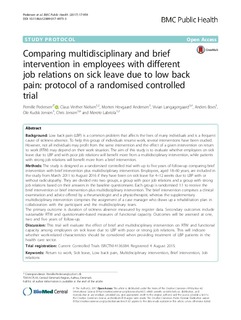| dc.contributor.author | Pedersen, Pernille | |
| dc.contributor.author | Nielsen, Claus Vinther | |
| dc.contributor.author | Andersen, Morten Hovgaard | |
| dc.contributor.author | Langagergaard, Vivian | |
| dc.contributor.author | Boes, Andreas | |
| dc.contributor.author | Jensen, Ole Kudsk | |
| dc.contributor.author | Jensen, Chris | |
| dc.contributor.author | Labriola, Merete | |
| dc.date.accessioned | 2018-08-27T07:39:41Z | |
| dc.date.available | 2018-08-27T07:39:41Z | |
| dc.date.created | 2018-02-26T16:12:14Z | |
| dc.date.issued | 2017 | |
| dc.identifier.citation | BMC Public Health. 2017, 17 (1), . | nb_NO |
| dc.identifier.issn | 1471-2458 | |
| dc.identifier.uri | http://hdl.handle.net/11250/2559367 | |
| dc.description.abstract | Background
Low back pain (LBP) is a common problem that affects the lives of many individuals and is a frequent cause of sickness absence. To help this group of individuals resume work, several interventions have been studied. However, not all individuals may profit from the same intervention and the effect of a given intervention on return to work (RTW) may depend on their work situation. The aim of this study is to evaluate whether employees on sick leave due to LBP and with poor job relations will benefit more from a multidisciplinary intervention, while patients with strong job relations will benefit more from a brief intervention.
Methods
The study is designed as a randomised controlled trial with up to five years of follow-up comparing brief intervention with brief intervention plus multidisciplinary intervention. Employees, aged 18–60 years, are included in the study from March 2011 to August 2016 if they have been on sick leave for 4–12 weeks due to LBP with or without radiculopathy. They are divided into two groups, a group with poor job relations and a group with strong job relations based on their answers in the baseline questionnaire. Each group is randomised 1:1 to receive the brief intervention or brief intervention plus multidisciplinary intervention. The brief intervention comprises a clinical examination and advice offered by a rheumatologist and a physiotherapist, whereas the supplementary multidisciplinary intervention comprises the assignment of a case manager who draws up a rehabilitation plan in collaboration with the participant and the multidisciplinary team.
The primary outcome is duration of sickness absence measured by register data. Secondary outcomes include sustainable RTW and questionnaire-based measures of functional capacity. Outcomes will be assessed at one, two and five years of follow-up.
Discussion
This trial will evaluate the effect of brief and multidisciplinary intervention on RTW and functional capacity among employees on sick leave due to LBP with poor or strong job relations. This will indicate whether work-related characteristics should be considered when providing treatment of LBP patients in the health care sector. | nb_NO |
| dc.language.iso | eng | nb_NO |
| dc.publisher | BioMed Central | nb_NO |
| dc.rights | Navngivelse 4.0 Internasjonal | * |
| dc.rights.uri | http://creativecommons.org/licenses/by/4.0/deed.no | * |
| dc.title | Comparing multidisciplinary and brief intervention in employees with different job relations on sick leave due to low back pain: Protocol of a randomised controlled trial | nb_NO |
| dc.type | Journal article | nb_NO |
| dc.type | Peer reviewed | nb_NO |
| dc.description.version | publishedVersion | nb_NO |
| dc.source.pagenumber | 7 | nb_NO |
| dc.source.volume | 17 | nb_NO |
| dc.source.journal | BMC Public Health | nb_NO |
| dc.source.issue | 1 | nb_NO |
| dc.identifier.doi | 10.1186/s12889-017-4975-3 | |
| dc.identifier.cristin | 1568809 | |
| dc.description.localcode | © The Author(s). 2017 Open Access. This article is distributed under the terms of the Creative Commons Attribution 4.0 International License (http://creativecommons.org/licenses/by/4.0/) | nb_NO |
| cristin.unitcode | 194,65,20,0 | |
| cristin.unitname | Institutt for samfunnsmedisin og sykepleie | |
| cristin.ispublished | true | |
| cristin.fulltext | original | |
| cristin.qualitycode | 1 | |

